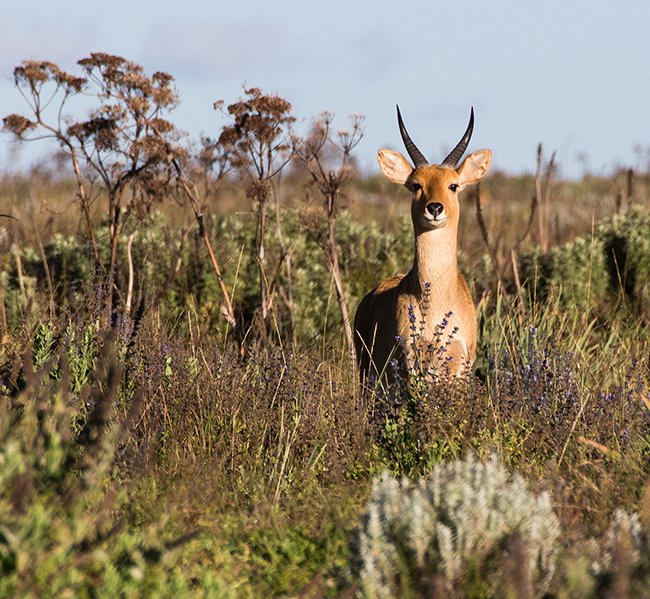What’s Hiding in the Savannah?
David Castor, Public Domain via Wikimedia Commons
Reduncinae
by Inspector Barry Mins on December 7, 2021Hey kids, welcome back to our series on the mysteries of created kinds!
Last week we were introduced to our second kind, the black-capped donacobius, a beautiful songbird from South America. As we wrapped up last week, I gave you all a clue about this week’s created kind. Did anyone figure it out? Let us know!

This week we move on to our first kind with more than one species. It’s also our first mammal. There are two genera in this kind, consisting of nine living species and another nine known only from fossils. This kind is limited to Africa, specifically sub-Saharan and West Africa. Some species have huge ranges, while others are much more limited and sparser.
This kind lives primarily in wetlands in and around the well-known African savanna.1 Because the savanna is featured in many wildlife documentaries, some of you may have seen the species in the header before. These species are social organisms, generally living in groups called herds. Habitats vary between species, with some liking light woodlands near permanent water, while others prefer rock outcrops and shrubs.2
Every member of this kind is fully vegetarian. They can form massive populations, but their populations are food-limited. If food availability declines, the large herds shrink by as much as 40%.3 Diet varies by species, with some species feeding largely on grasses,4 while others prefer annual flowering plants when they sprout during the rainy season but settle for grass when flowering plants are not available.5 A third species eats only flowering plants, with the occasional tree in the dry season.6 Populations of this kind tend to be biased towards females.7 Females may mate with multiple males to ensure they successfully conceive a baby.8 The species are sexually dimorphic, with the males having much more prominent horns.
Any clues yet? This week’s kind is the reedbuck kind. Limited to Africa, this antelope kind’s most well-known species is the waterbuck. Many species have one or more subspecies as well.

Bohor Reedbuck
David Castor, Public Domain via Wikimedia Commons
Want to test your knowledge? Try out this crossword puzzle!
Stay tuned for next week, when we travel to the Democratic Republic of Congo to look for a small amphibian. Your clue for the week is:
Clue
This kind has just one species, lives in tropical forests, and has an “X” on its back.
Footnotes
- Fenton Cotterill “Reduncine antelope of the Zambezi Basin” in Zambezi Basin Wetlands Volume II ed. J.R. Timberlake, Biodiversity Foundation for Africa, Bulawayo, Zimbabwe, 2000.
- U. de V. Pienaar “Habitat-preference in South African antelope species and its significance in natural and artificial distribution patterns.” Koedoe 17 (1974), 185-195.
- J.M. Fryxell “Food limitation and demography of a migratory antelope, the white-eared kob.” Oecologia 72 (1987), 83-91.
- Vera Rduch “Diet of the puku antelope (Kobus vardonii) and the dietary overlap with selected other bovids in Kasanka National Park, Zambia.” Mammal Research, 61 (2016), 289-297.
- Brathelemy Kassa, Roland Libois, and Brice Sinsin “Diet and food preference of the waterbuck (Kobus ellipsiprymnus defassa) in the Pendjari National Park, Benin.” African Journal of Ecology, 46, no. 3 (2008), 303-310.
- Yonas Derebe and Zerihun Girma “Diet composition and preferences of Bohor reedbuck (Redunca redunca) in the compound of Alage College, Central Rift Valley of Ethiopia.” Ecology and Evolution, 10, no. 23 (2020), 13370-13381.
- R.K.B. Jenkins, G. Corti, E. Fanning, S. Gordon, and R.J. Hinde “Observations on the puku antelope (Kobus vardoni Livingstone, 1857) in the Kilombero Valley, Tanzania.” African Journal of Ecology 40, (2002), 197-200.
- Andrew Balmford, Steve Albon, and Sarah Blakeman “Correlates of male mating success and female choice in a lek-breeding antelope” Behavioral Ecology, 3 no. 2 (1992), 112-123.
- © 2025 Answers in Genesis
- Privacy Policy
- Contact
- About
